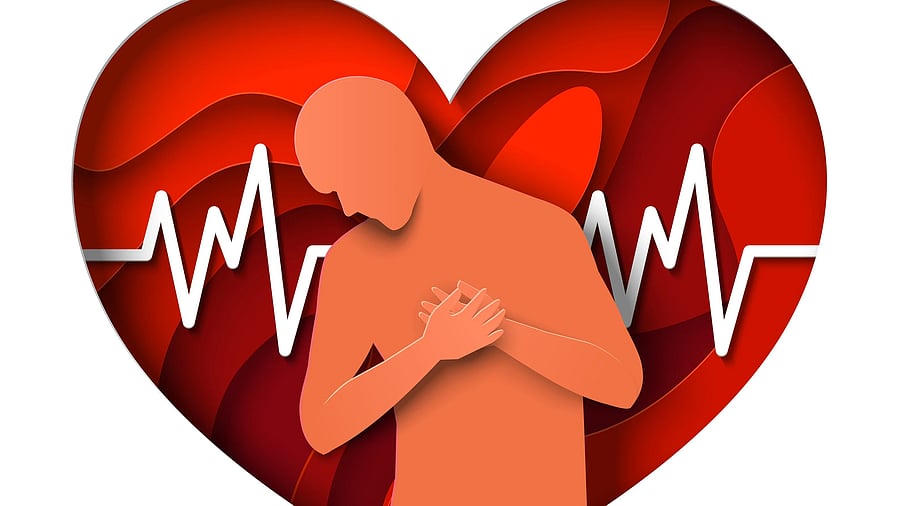
Dr Pradeep Haranahalli
The rising number of heart attacks among young people may seem like an isolated issue pertaining to India alone, but it is part of a larger global health trend. In Western countries, although overall heart attack rates are declining, the age at which people experience their first heart attack is steadily decreasing. Similarly, in India, heart attacks are becoming more common in individuals in their 20s, 30s, and 40s. Alarmingly, 50% of all heart attacks now occur in people under 50, with 1 in 5 happening in those under 40.
This troubling trend is a nationwide issue, with men being more affected than women, and no region is spared. A combination of lifestyle changes, genetic factors, and traditional risk factors, such as rising rates of diabetes, hypertension, obesity, and dyslipidemia, is at the heart of this surge. These conditions are often linked to poor lifestyle choices.
Key contributing factors
Genetic predisposition: South Asians, comprising people from India, Pakistan, Bangladesh, Nepal, Sri Lanka, Bhutan, and the Maldives, are genetically predisposed to heart attacks. This is due to higher levels of certain cholesterol particles, like lipoprotein (a), and lower levels of HDL (the “good” cholesterol). Additionally, South Asians experience higher insulin resistance and a reduced ability to repair blood vessel damage, further elevating their risk, regardless of their geographic location.
Diabetes in the young: Diabetes has reached epidemic levels in India, particularly among the younger population. Over the past 15 years, the number of diabetes diagnoses has doubled, and 1 in 4 individuals aged 15-24 are now living with the condition. Diabetes is often discovered during routine health checks or after a young person suffers a heart attack.
Obesity, poor eating habits, and sedentary lifestyles: Obesity is on the rise, driven by factors such as mechanisation, reduced physical activity, and an increase in sedentary behaviours. While many attribute weight gain to the Covid-19 lockdowns, this trend has been ongoing. Urban environments, with their emphasis on convenience — like food delivery services, screen time, and work-from-home arrangements, further contribute to the rise in obesity.
Smoking, vaping, and substance abuse: Smoking is a known risk factor for heart attacks, but vaping, despite being banned in India, remains accessible to youth. The use of substances like cocaine, which causes severe spasms in coronary arteries, is another hidden cause of heart attacks in young people, though it is often underreported.
Chronic stress and mental strain: The fast pace and high demands of urban life contribute significantly to chronic stress. This stress often manifests in work pressure, financial strain, relationship issues, and sleep disturbances. In response, tobacco and alcohol consumption often increase, further heightening the risk of heart attacks.
Air pollution: Emerging research shows that exposure to particulate matter (PM 2.5), a form of air pollution, is a significant risk factor for heart attacks. PM 2.5 promotes atherosclerosis, causes inflammation in blood vessels, encourages clot formation, and is linked to hypertension, all of which strain the heart.
hs-CRP (High-Sensitivity C-Reactive Protein): hs-CRP is a promising marker for predicting heart attacks, as it indicates inflammation in the body. Chronic low-level inflammation is a key factor in atherosclerosis, which can lead to heart attacks. A 2008 study (JUPITER trial) involving over 17,000 participants found that elevated hs-CRP levels above 3 mg/L significantly increased heart attack risk, even in individuals with normal cholesterol levels. Statin medications like rosuvastatin can lower hs-CRP levels, reducing heart attack risk by 54%. Lifestyle changes, such as eating antioxidant-rich foods, exercising, managing weight, and quitting smoking and alcohol, can also lower hs-CRP levels. However, hs-CRP is not without limitations. While it indicates inflammation, it does not pinpoint the specific cause of the inflammation. Elevated hs-CRP can also result from infections, chronic diseases, obesity, or certain medications. Therefore, hs-CRP levels should be interpreted by a physician.
A growing concern
With heart attacks occurring at younger ages, it’s crucial to move beyond traditional risk factors like diabetes, high blood pressure, and smoking.
Newer markers — such as hs-CRP, lipoprotein(a), and Apo B — should be explored and tested to better assess and reduce heart attack risk in young people.
(The author is a consultant and interventional cardiologist.)